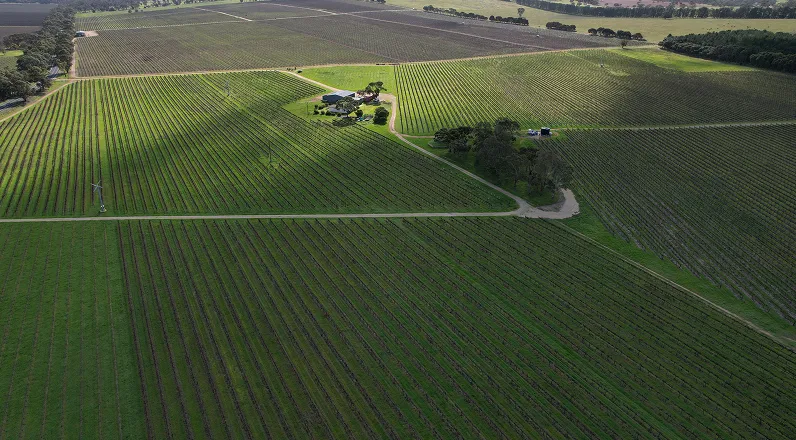Water Use
Introduction
Irrigation of vineyards is a common practice in almost all wine-producing countries worldwide, although it is (currently) forbidden by law in many traditional European wine regions.
It is particularly common at the commercial end of the wine sector, with irrigation necessary to produce the larger crop loads required. At the fine wine end of the sector, the use of irrigation varies by country and region, where it generally plays more of a vine health and balance role to help mitigate climatic conditions and variabilities.
The efficient and sustainable use of water is crucial no matter what part of the wine sector it is being used for. As a finite resource, it needs to be used wisely to ensure its continued availability for wine production.
Irrigation practices have evolved over time with advancements in system design and new technologies to deliver and measure the amount of water needed to produce a given crop. Regenerative Viticulture’s role in this is to highlight the best practice methods of these advancements but to also look at the natural water cycles within vineyards and develop management systems that enhance the ability to capture, store, and recycle water through their vineyard system. This is known as regenerative hydrology and water stewardship. It can be extended to whole water catchment systems.
In detail
Although not technically essential to vine growth, irrigation is almost always used in commercial winegrowing where it is permitted to allow for variations in rainfall conditions and to aid in crop management and quality control.
The way irrigation is applied varies greatly from country to country depending on supply, storage, system design, cultural practices, and education.
Traditionally, where irrigation was first introduced into vineyards it was in the form of flood or furrow irrigation. This required little or no infrastructure and used large amounts of water to wet all or parts of the vineyard floor. This led to heavy tillage of vineyard soils to reduce competition and resistance to water movement.
New technology enabled many of these systems to be converted to sprinkler irrigation. This allowed the entire vineyard soil profile to be irrigated, but with less manual labour and a little more control over how much water was being applied. These systems were also an improvement over flood and furrow irrigation in terms of efficiency, and this system didn’t require the vineyard to be fully cultivated, although many still were.
The most advanced irrigation systems used in vineyards now consist of drip irrigation either above or below ground, with emitters placing water either at individual vines or in a wetted sausage along the vine row. These systems can be highly automated, allowing them to run at night when evapotranspiration is lower, and give a much higher degree of accuracy to the amount of water delivered to each vine. The advent of highly accurate and advanced moisture monitoring equipment (both soil and plant sensors) has streamlined the application of water to allow for as little wastage as possible. These systems allow for easy data collection and measurement of water used over the season and should be used to track usage and manage water resources in a sustainable manner.
Arguably the most efficient water use vineyard is one that does not require water at all (dry grown). This can be achieved in several ways:
- Improving soil water holding capacity
- Restoring small natural water cycles
- Holding water on farm for longer periods using techniques such as Keyline water management
- Increasing the root mass of the vines so that they access a greater volume of soil
Recently the use of treated urban wastewater for irrigation has been another way to ensure that water is used more than once and not discharged into oceans or rivers. In many cases it has allowed vineyards to stop using aquifer and stream water to allow these natural storages to recharge and recover.
Regenerative hydrology is a relatively new concept that is being used to counter the new weather patterns of droughts followed by extreme precipitation events. Traditional vineyard rows going down slopes, with bare soils underneath, resulted in water running down the slopes, talking top soil with it. Conventional management was to install drainage to enable that to flow away from the vineyard as quickly as possible. However this leads to high flows into streams. We now understand that we need to keep every drop of water on our land, so it is available when needed in times of drought. New hydrological design techniques are being used to build water infrastructures that slow down the passage of water through the vineyard, distributing it, allowing it to infiltrate and storing it in basins. This includes keyline contour planting, earthworks, agroforestry, keeping the soil covered, etc.
Further information
- Yeomans Keyline Systems Explained
- Article by Tamlyn Currin in Jancis.com on the regenerative hydrology works undertaken at Chateau Galoupet in Provence
- What is water is more important than carbon? 4 minute film by Alpha Lo on the water cycle and the cycle of drought-fire-flood
- Interview with Alain Malard on regenerative hydrology
- RVF and Porto Protocol webinar on regenerative hydrology with Mimi Casteel and Alpha Lo
- Porto Protocol webinar on water-clever vineyards
- The Challenge of Landscape, original 1958 paper by P.A. Yeomans
- Sentek Technologies
- Plant Water Management | Athena IR-Tech
- Precision Agriculture – SupPlant
- Permalab | Regenerative Agriculture and Hydrology regenerative hydrology consultants in France






